Door County is the easternmost county in Wisconsin, situated on a peninsula. It is named after the strait between the Door Peninsula and Washington Island. The passage through the strait is known as Death’s Door and was aptly named. Because of the narrow waterway, hidden sandbanks, and unpredictable gale forces coming off the Great Lakes, navigating this passage could be deadly for sailors in the 1800s. In fact, there are over 240 shipwrecks resting beneath the waters around the peninsula. Here are the 14 most amazing shipwrecks in Wisconsin’s Door County.
1. Australasia

The crew fought the
Australasiafire briefly but then abandoned the vessel. A tow brought the ship
to a beach south of Cave Point for scuttling.
©https://greatlakeships.org/2904455/data?n=2, Public domain – Original / License
This ship first hit the waters on September 17th, 1884. At 285 feet long, Australasia held the title of the largest wooden vessel ever built when she was completed. Over her 12-year career, Australasia carried bulk cargo across the Great Lakes with incredible efficiency for a wooden craft. However, on October 17, 1896, Australasia caught fire beneath the deck.
The crew fought the fire for a short time before abandoning the vessel. Then, a towing vessel dragged Australasia to a beach south of Cave Point, where Australasia was scuttled. Today, she lies in 15 feet of water off Whitefish Dunes State Park and is one of the popular shipwrecks in Wisconsin’s Door County.
2. Christina Nilsson

Gale winds and a blizzard led to
Nilssonaground in Bailey Harbor. She still sits off the old Baileys Harbor Light.
©http://greatlakeships.org/2904028/data?n=6, Public domain – Original / License
This $23,000 three-masted schooner was named for a renowned Swedish diva. Constructed at the shipyard of Hanson & Scove in Manitowoc, Wisconsin, this shipyard was responsible for nearly 39 percent of all sailing crafts made in Manitowoc between 1871 and 1885. Since Nilsson’s first voyage in August of 1871, Nilsson had a fairly smooth career of transporting bulk grain and iron cargo until her demise in 1884. On October 25, 1884, Nilsson ran aground in Baileys Harbor after being battered by gale winds and a blinding blizzard. Today, she lies off the old Baileys Harbor Light in 15 feet of water.
3. City of Glasgow

The
City of Glasgowwreckage sits about 100 yards from shore in Lily Bay.
©AlenaMozhjer/iStock via Getty Images
The City of Glasgow began as one of the largest wooden freighters of the Great Lakes in 1891. Used primarily to transport bulk cargo like coal, this vessel had a few makeovers before becoming the stone barge known as Glasgow. At this time, the Door County stone quarry relied heavily on Glasgow to ship limestone across the lakes. Then, in October 1917, both the Glasgow and the Adriatic were being towed when a strong storm hit the area.
The tow line broke, and the next day, the Sturgeon Bay Coast Guard found Glasgow grounded on a beach. While there were many attempts to free the ship that day and weeks after, she wouldn’t move. Glasgow was officially abandoned in 1922, and the wreckage can be found roughly 100 yards from shore in Lily Bay, three miles north of the Sturgeon Bay Ship Canal.
4. Fleetwing
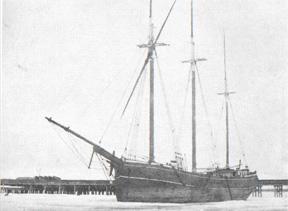
sits in 15 feet of water in Garrett Bay.
On the evening of September 26, 1888, this three-masted schooner was piled high with a load of lumber bound for Chicago. Traveling for Death’s Door, Captain Andrew McGraw mistook one of the bluffs as a familiar landmark and sailed into Garrett Bay. Unfortunately, Fleetwing struck a rocky beach, and before she could be tugged out, a gale storm broke the hull in two. Today, Fleetwing lies in 15 feet of water near the Garrett Bay boat launch.
5. Grape Shot
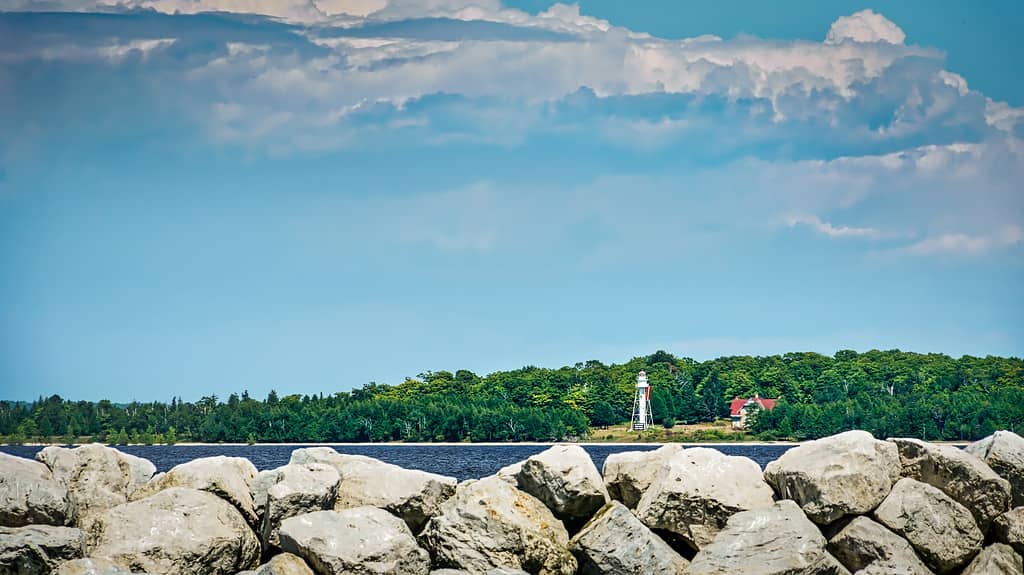
After running aground the rocks in 1867,
Grape Shotnow sits in the waters near Plum Island.
©Bill Chizek/iStock via Getty Images
This schooner grounded near Plum Island in the midst of a gale on November 1867. She was so thoroughly stuck upon the rocks that her bow was four feet in the air. The tug Leviathan, based in Chicago, was sent to rescue Grape Shot. But after several attempts, the Grape Shot had to be abandoned. Her 50,000 board feet of lumber and salt were unloaded and taken to Chicago, and her rigging was removed. The well-preserved wreckage of Grape Shot sits in eight feet of water near Plum Island and is an important archaeological research site.
6. Louisiana

wrecked on the rocks of Washington Harbor and sits there today under 18 feet of water.
©Bowling Green State University, Public domain – Original / License
Built in 1887, Louisiana had 26 strong years of service before her unfortunate end. In November 1913, Louisiana passed through Death’s Door but was hit with a severe snowstorm, now known as “The White Hurricane of 1913.” The winds tossed the vessel ashore in Washington Harbor, and the cargo hold caught fire. The crew was forced to abandon the ship, and Louisiana was wrecked upon the rocks. Today, she lies in 18 feet of water in Washington Harbor.
7. Forest
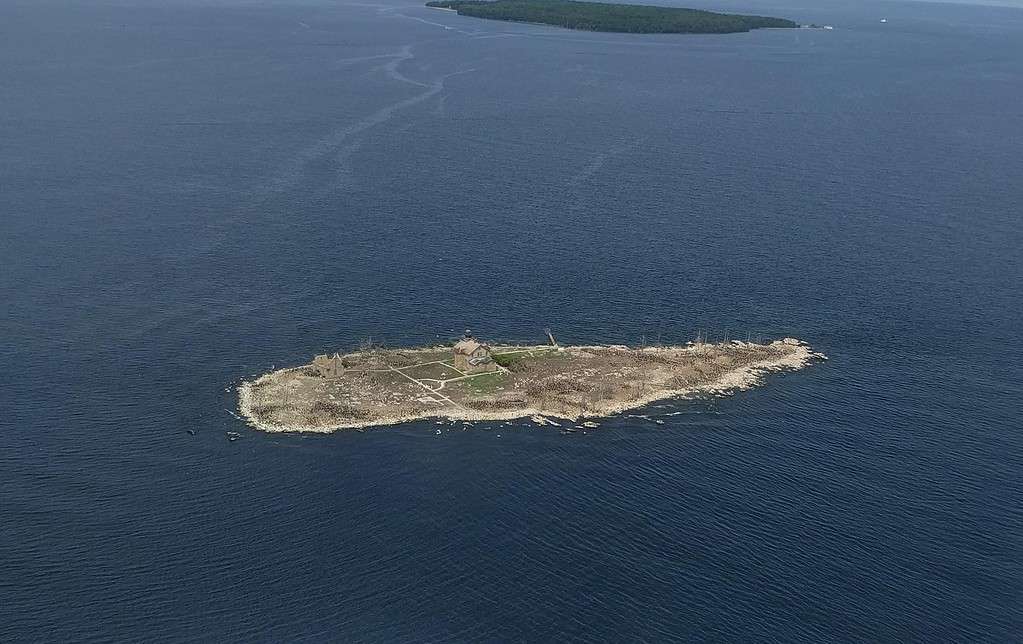
Pilot Island is the site of three sunken vessels and makes up the Pilot Island Northwest Site.
The wreckage of the Forest, A.P. Nichols, and J.E. Gilmore are all located in the same spot. These sunken vessels comprise the Pilot Island Northwest Site and are listed on the National Register of Historic Places. Forest was the first of the three to run aground near Pilot Island on October 28, 1891. Then, around the same time a year later, A.P. Nichols caught a reef right by Forest. And then, on October 17, 1892, J.E. Gilmore was wrecked on a rock shelf next to the other two ships. Today, all three may be found in 35 feet of water by Pilot Island and are frequented shipwrecks in Wisconsin’s Door County.
8. A.P. Nichols
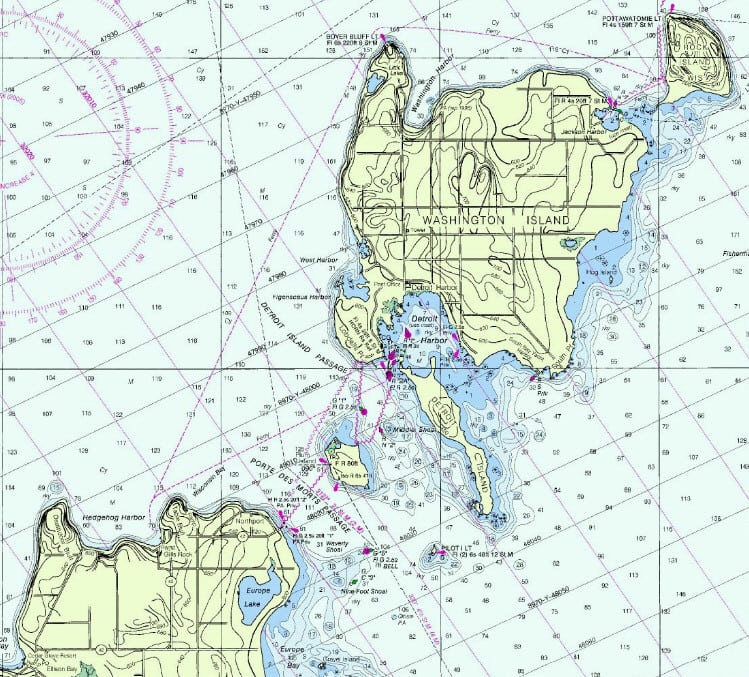
Porte Des Morts Passage is also known as “Death’s Door.” Pilot Island, the wreckage site of
A.P. Nicholsand two others, is located on the southeastern portion.
Built as a schooner for general trade along the Great Lakes, A.P. Nichols was involved in three collisions between 1887 and her final voyage in 1892. That October day, a gale caught A.P. Nichols, and she turned toward Plum Island for refuge. But, A.P. Nichols drifted toward Pilot Island and caught on a reef right next to the bow of Forest, which had been trapped there the previous year. Before being recovered, a storm in March 1893 broke apart A.P. Nichols, making the waters by Pilot Island her final resting place.
9. J.E. Gilmore
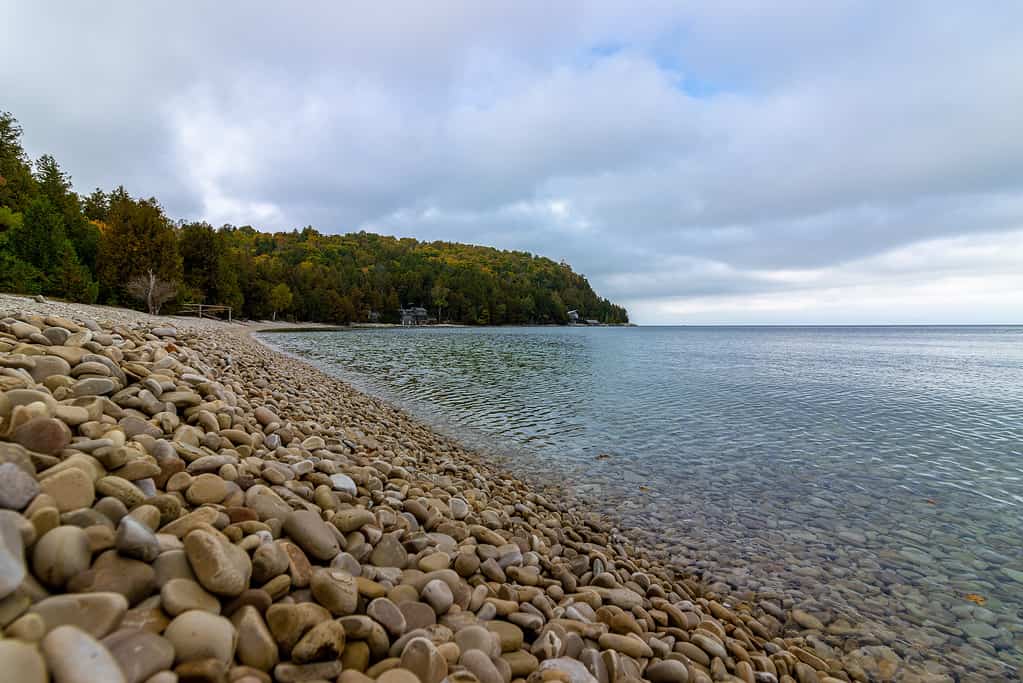
navigated the waters of Lake Michigan through Death’s Door when she hit a reef by Pilot Island.
©Wirestock/iStock via Getty Images
This wooden, two-masted schooner was also a victim of the reefs around Pilot Island. In October 1892, J.E. Gilmore tried to outrun bad weather chasing her through Death’s Door. Unfortunately, she hit a reef southwest of Pilot Island and then was tossed on a rock shelf very close to Forest. You may see J.E. Gilmore in 35 feet of water by Pilot Island.
10. Emeline
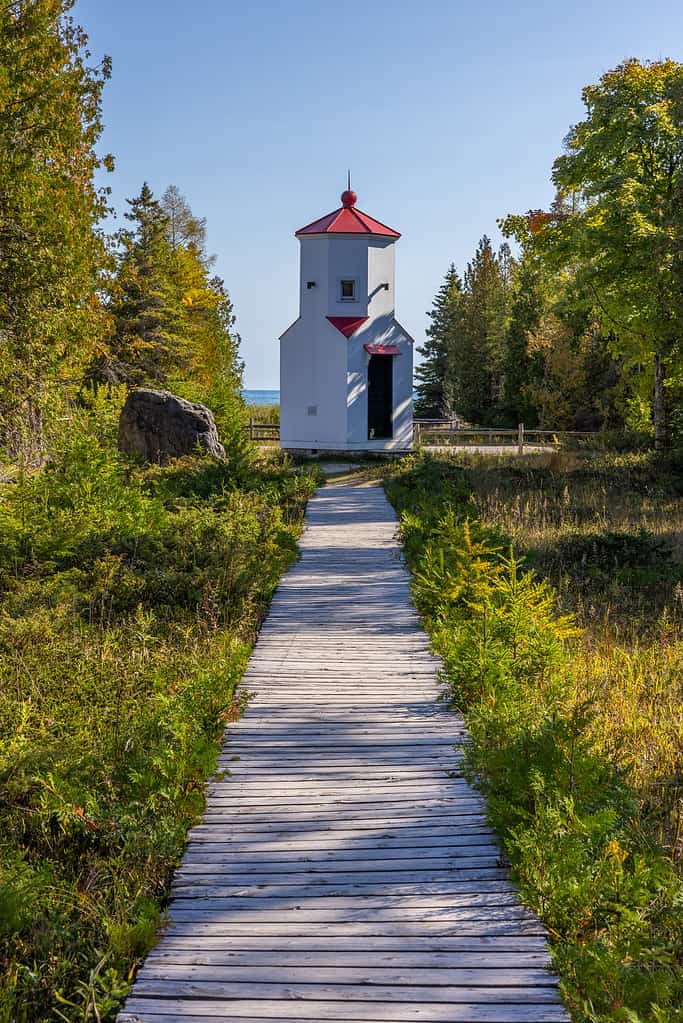
Despite efforts to salvage her, the wreckage of
Emelineremains in 21 feet of water off of Baileys Harbor.
©John_Brueske/iStock via Getty Images
On her way to Kenosha, Wisconsin, this three-masted schooner was carrying a load of tamarack bark when high winds struck Emeline. The vessel capsized, though the crew was able to escape safely. Several attempts were made to salvage Emeline, but eventually, she sank off Anclam’s Pier. Today, what’s left of Emeline may be found in 21 feet of water off of Baileys Harbor.
11. Perry Hannah
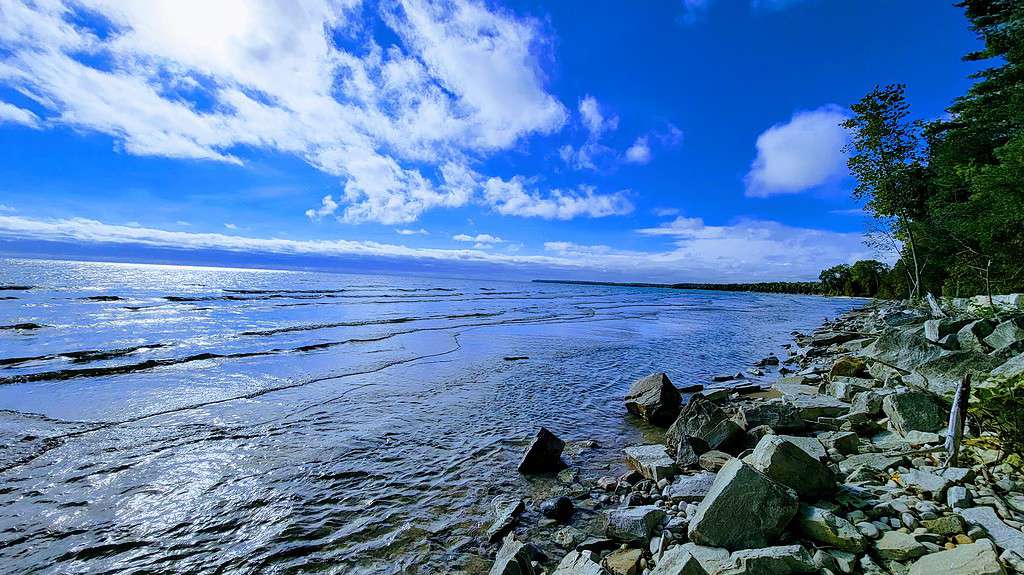
While in the middle of loading at Jacksonport, a severe caused the
Perry Hannahto wreck on a nearby pier.
While loading hemlock ties at Jacksonport in October 1880, Perry Hannah was hit by a severe gale and was wrecked on Reynold’s pier, causing $2,500 worth of damage. Today, you may see the remains of the two-masted schooner in eight feet of water between the piers. Perry Hannah, Cecelia, and what’s left of the Reynolds Pier comprise the Reynolds Pier Historic Site off of Jacksonport Beach. This is another popular place to visit for shipwrecks in Wisconsin’s Door County.
12. Cecelia
Also part of the Reynolds Pier Historic Site off of Jacksonport beach, you can see Cecelia in about six feet of water by the pier. While loading cargo on September 9, 1885, the Cecelia was wrecked around the same spot as Perry Hannah five years earlier.
13. Frank O’Connor
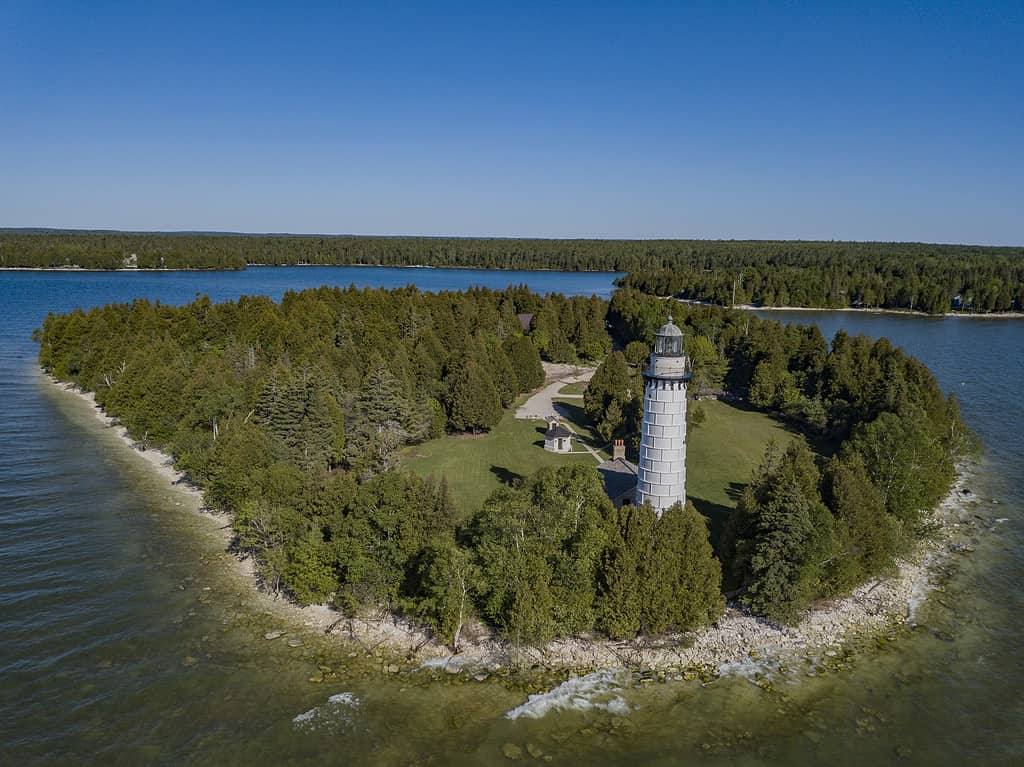
Just two miles off of Cana Island is the final resting place of
Frank O’Connor.©John Touscany/iStock via Getty Images
On Frank O’Connor’s 26th year of service, the ship was heading out of Buffalo, New York, with 3,000 tons of coal. Suddenly, a fire broke out on the bow off the east coast of Door County. Luckily, the whole crew evacuated, but Frank O’Connor could be seen burning well into the night. On October 21, 1919, the steamer burned to the waterline and sank. Today, Frank O’Connor may be seen in 65 feet of water, only two miles off of Cana Island.
14. Lakeland

The wreckage of
Lakelandis well-preserved, as are the cars in her hold, despite the damage it sustained.
©https://greatlakeships.org/2907499/data?n=5, Public domain – Original / License
When she was first constructed, Lakeland was first known by the name Cambria. She was crafted as a steel-hulled freighter at the cost of $160,000. She took her first voyage on February 1, 1887. Used mostly to haul a couple thousand tons of ore between Escanaba and Ohio ports, she was later reconstructed as a car carrier.
With 40 Nash and Kissel cars as her cargo, on December 3, 1924, Lakeland sprung a leak before entering the canal. Despite the crew’s efforts, they abandoned the 2,425-ton iron steamer, and she sank six miles east of Sturgeon Bay. The vessel rests in 205 feet of water, and though it broke into several pieces, it is remarkably well preserved, as are the cars in her hold. Of all these shipwrecks, Lakeland is the most interesting shipwrecks in Wisconsin’s Door County because of the preserved cars.
Thank you for reading! Have some feedback for us? Contact the AZ Animals editorial team.









